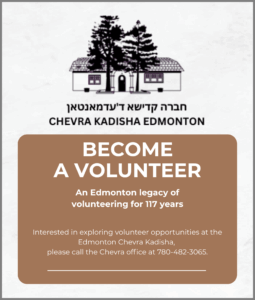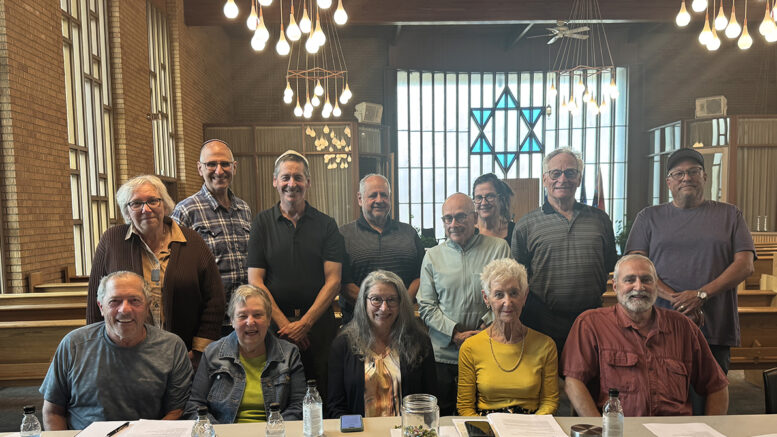by Maxine Fischbein
(AJNews) – The Edmonton Chevra Kadisha, which has served the Jewish community continuously since its establishment in 1907, is an organization steeped in tradition and halacha. Counterintuitively, it is also committed to morphing in new directions that will help the sacred society better serve a changing community.
An example of the Jewish burial society’s commitment to an increasingly diverse community is the effort currently underway to fund and open an interfaith burial section at the Chevra’s still new northside cemetery, located on 156 Street at 147 Avenue, say Jeff Rubin and Barry Goldberg.
Rubin, who ascended to the presidency of the Chevra this past May, follows in the footsteps of his father, Abner Rubin, of blessed memory, who was a committed Chevra volunteer for decades. Goldberg, a friend of Rubin’s since childhood, serves as vice president following years of service to other bedrock Jewish institutions in Edmonton. Other key volunteers in the current executive include Ken Soroka (treasurer), Sharon Hundert (secretary) and David Marcus (immediate past president).
“Never in the history of the Chevra has there ever been an advertisement of who is on the board of the Chevra because it was considered a secret society,” Rubin told AJNews last month.
 “In our mind, it is a sacred society. The only secret part of the Chevra should be the Taharahs [ritual preparation of the deceased prior to burial]. For everything else we want to be more transparent with the community moving forward,” said Rubin who wants to bust myths about the society, including the persistent belief that the Chevra is flush with cash.
“In our mind, it is a sacred society. The only secret part of the Chevra should be the Taharahs [ritual preparation of the deceased prior to burial]. For everything else we want to be more transparent with the community moving forward,” said Rubin who wants to bust myths about the society, including the persistent belief that the Chevra is flush with cash.
The Chevra does have some $2.5 million in its coffers, but the funds are held in trust for the eventual burial of community members who have pre-purchased plots and for perpetual care of the northside cemetery and the original southside cemetery on 101 Avenue at 76 Street.
Rubin and his board wish to be transparent with the community and plan to share information about the society’s operations, including revenues and expenses, to create a collective understanding of how the society operates.
They have already demonstrated their commitment to open discussion with Jewish Edmontonians of all levels of religious observance regarding policy changes that will allow the Chevra to serve the breadth of an evolving community.
The establishment of an interfaith section at the new cemetery, was proposed by a Chevra committee co-chaired by Karen Hering and Bill Dolman. The committee, including Chevra secretary Sharon Hundert, conducted extensive research into services provided by Chevra Kadisha organizations across Canada, Rubin said.
At a recent special meeting held by the Edmonton Chevra Kadisha, an overwhelming majority expressed support for interfaith burials in a designated section of the new Jewish Cemetery.
“We are now fundraising for that interfaith section,” said Rubin, who is sensitive to the fact that the move remains a “contentious issue,” especially with some long-serving Chevra members and members of the Jewish community at large who favour a more traditional approach.
Rubin and his team remain committed to engaging with all community members including those with differing views.
“The percentage of interfaith marriage is growing enormously, and it just makes sense that they want to be buried together,” said Rubin.
Development of the interfaith section depends on the generosity of Jewish Edmontonians. Land has been set aside to the east of the burial ground consecrated for Jewish burials on June 4, 2023, when the northside cemetery officially opened.
Sharon Marcus is heading up fundraising for the interfaith section for which the fundraising goal is $400,000. The funds will cover clearing, excavation, grading, grade beams, walkways, landscaping, lighting, security cameras and permits.
Burials in the interfaith section will commence once the Chevra raises $250,000, say Rubin and Goldberg, adding that donations to date total approximately $150,000.
The Chevra Kadisha has considered interfaith burial policies and procedures in other Jewish communities as they build policies that best suit the Edmonton Jewish community.
There is already certainty on two matters. The Chevra will not allow clergy members of other faiths to officiate interfaith funerals at the cemetery. Similarly, they will not permit crosses and other iconography related to the faiths of non-Jewish partners on headstones.
“We met with the committee, the board, the Chevra as a whole and… the community to make sure that everyone was onboard but also to listen to people who weren’t,” said Goldberg.
“We felt confident, once the vote was taken, that we answered most questions to the satisfaction of the majority,” Goldberg added.
“A lot of people who were against the idea initially… came on board,” said Rubin, especially when they understood that the burials will take place in an unconsecrated section of the cemetery.
“We feel very strongly that we are meeting the needs of Edmontonians who have [non-Jewish] partners, and we feel good about that,” Goldberg said.
“We are trying to be as sensitive and realistic as possible,” says Goldberg, adding that the burial of interfaith family members is but one of many priorities for the Chevra.
“The beautiful thing about the Chevra is that we are going to be flexible. We will talk about our policies and procedures… we are going to be open to change, but it has to be [carried out] within certain parameters,” says Goldberg, adding that halacha and minhag (Jewish laws and customs) will continue to guide the organization.
A prime concern is compassion for those who grieve, say Rubin and Goldberg who recently met with Danielle Dolgoy, Executive Director, and Meital Siva-Jain, Manager of Outreach Services, at Jewish Family Services Edmonton, to plan for an ongoing partnership devoted to meeting the needs of bereaved family members,” Rubin told AJNews.
While Chevra work is a calling, it is also a business, and Rubin has set about the establishment of committees devoted to governance, risk management, financial oversight, and the like to ensure that the organization operates with maximum efficiency.
Unlike other Canadian Chevra Kadisha organizations—with the exception, in part, of Calgary—the Edmonton Chevra owns and operates its cemeteries.
While Rubin and Goldberg are confident that the Chevra will continue to serve future generations of Jewish Edmontonians, the organization’s ability to do so hinges upon the willingness of new generations of volunteers to perform taharahs, assist at burials, and comfort the bereaved.
“It’s a challenge to find younger members,” says Rubin.
“When I lost my sister, my mother, and a few close friends, I saw the need for the Chevra, recalls Goldberg, who wanted to give back, a motivation that has attracted other Jewish Edmontonians to the sacred work for close to 120 years.
“Often people say, ‘Oh my God, it’s such a mitzvah you’re doing’,” Goldberg to AJNews. “But we don’t look at it that way…. It may be a calling, but it is about helping other people. When you are in that position on the other side of the table, you are farmisht [disoriented] because you’ve lost somebody near and dear.”
Like many volunteers who gravitate to the Chevra, Jeff Rubin follows in the footsteps of his father Abner Rubin, of blessed memory. Over the years, Abner encouraged his son to step up, as he had, on behalf of the Chevra.
“I just wasn’t ready yet,” recalled Jeff Rubin who answered the call approximately 20 years ago.
Rubin says that people often assume that all Chevra volunteers must participate in Taharahs.
“Not everyone is able to do a taharah,” says Rubin. “For some it takes a while if they are ever going to do it, but there are other roles that a Chevra member can fulfill.”
Tasks conducted by Chevra volunteers include answering phones, attending funerals to assure a minyan (the prayer quorum of 10 required for the recitation of the Kaddish prayer), meeting with bereaved families, and sewing tachrichim (shrouds).
The Edmonton Chevra, which averages 35 to 40 funerals each year, recently appointed Matthew Marcus as cemetery manager. Marcus, who previously worked at the southside cemetery, will be responsible for both cemeteries and will be a presence at the Chesed Shel Emes building on 105 Avenue at 123 Street.
Other paid employees include office manager Lauren Baram and casual labourers.
The Chevra plans to eventually erect a building at the new cemetery site that will include taharah facilities, a chapel, offices, a Cohen room, and washrooms.
Last month, the building committee approved conceptual drawings, which they have now referred to the Chevra board of directors for their consideration at their September meeting, says Rubin. Once approved, design work and cost estimates will follow.
It is likely that the Chevra will eventually sell the Chesed Shel Emes building, though this is not a priority for now, Goldberg said. If they do sell the building before completion of the northside chapel, taharah teams will prepare the deceased for burial at the funeral home of Connelly-McKinley, partners of the Chevra over more than a century.
Temple Beth Ora rents space at the Chesed Shel Emes, where they conduct prayer services. The Reform congregation’s plan is to move to the new Jewish Federation building in about one year’s time, Rubin said.
The northside cemetery consists of 30 acres, approximately six of which the Chevra has already developed. According to various estimates, there is enough land to ensure Jewish burials there for a century or two.
Of course, this glimpse into the future of Jewish burial depends on the extent to which the community steps up, not only as volunteers but as philanthropists.
“We have a funding shortage,” says Goldberg.
Part of this arises from the fact that not all members of the community have the means to support, in whole or part, the burials of loved ones.
“Chevra needs to make that up,” Goldberg says, adding that today burials cost, on average, $15,500 to $16,000. Add to this the cost of perpetual care, and the figure rises to $18,000.
The board is giving thought to the re-establishment of a Kevurah (burial) Fund to which community members could direct donations to help defray the costs shouldered by the Chevra when individuals and families cannot afford interment, Rubin said, adding that this is a responsibility that falls not only to the Chevra but the community as a whole.
Many prepaid plots—some bought by community members decades ago— do not come close to the $18,000 sustaining figure. Although the Chevra will grandfather previous agreements, they are asking those in a position to do so to consider tax-deductible donations to bridge the gap.
“Times change. We have to move forward in all sorts of ways: morally, ethically, financially,” says Rubin, who values the counsel of Chevra past presidents and plans to continue meeting with them, keeping them informed, and ensuring that the community benefits from their wealth of experience.
Living past presidents of the Edmonton Chevra Kadisha include Harry Silverman, Percy Lerner, Rhoda Friedman, and David Marcus. Each has played a significant role in the unfolding story of one of Edmonton’s first and most important Jewish institutions, together with fondly remembered leaders now bound up in the bond of life.
Today’s Chevra leaders dedicate themselves to serving a community that has changed with the times but still needs the comfort of time-honoured Jewish traditions and compassionate support during their darkest hours.
If you are interested in exploring volunteer opportunities at the Chevra Kadisha, please call the Chevra office at 780-482-3065.
For more information about the interfaith burial section campaign contact Sharon Marcus at sharon@edmontonchevrakadisha.ca or 587-991-8437. Sponsorship opportunities are available.




Be the first to comment on "Edmonton Chevra Kadisha is meeting the needs of the Jewish community"